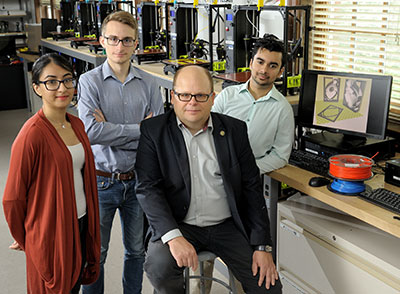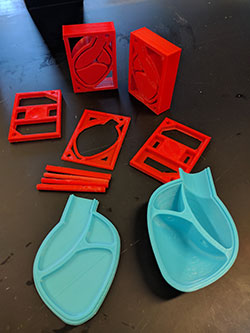
Each year seniors in bioengineering complete a capstone course where they develop design solutions for projects suggested by professors, industry professionals, and clinicians. In 2015, Wawrzyniec Dobrucki, an assistant professor of bioengineering and of medicine and a member of the Bioimaging Science and Technology Group, shared with the students an idea he had for a potential project—the creation of a heart phantom.
Many were interested but felt it would require more than the academic year to complete. Another group of students, however, heard about the idea and were intrigued by the project’s potential. They also were undeterred by a lengthy timeline for development.
Today, that group of students from the Biomedical Engineering Society is working with Dobrucki to develop PhantomCOR, a dynamic, multimodal heart phantom that can be used to test and validate new research protocols and novel imaging strategies.
Over the past 18 months, they have made significant progress. “We now have a working prototype of a two-chamber heart,” Dobrucki said. “And we have been able to use magnetic resonance imaging (MRI), x-ray computed tomography (CT), and ultrasound imaging to test how it works.”
Dobrucki’s idea for a heart phantom grew out of his research in the imaging of the cardiovascular system. “Existing heart phantoms don’t allow us to standardize our dynamic imaging protocols and imaging data,” he explained. That’s because existing versions are typically static and only work with one imaging method.

“Commercially available phantoms are also very expensive, so colleagues in preclinical research haven’t really considered them,” he continued. “With PhantomCOR, we’re looking to produce a complete dynamic heart phantom with a controllable pumping system at a more reasonable price.”
Mentoring Students
Dobrucki advised the students as they tested materials for the heart and developed the electrical and mechanical systems to control the artificial heart.
“Some models are made from hard plastic, which allows you to visualize the heart but doesn’t provide the vital information about the function of the heart,” said Dobrucki, the former director of the Molecular Imaging Laboratory in the Biomedical Imaging Center. “Ours is unique in that it allows you to study, modify, and visualize the myocardial function.”
How does the PhantomCOR concept work? A unique heart is first imaged using x-ray, CT or MRI techniques. Next, based on the acquired images, the individual molds are designed, 3D printed, and dynamic heart phantoms are casted with biocompatible materials.
The PhantomCOR team uses hydrogel or silicon for their material and a 3D printer to actually fabricate the replica. They have even developed a novel design for the 3D printed molds that allow them to incorporate physical deformities into the heart phantom. They continue to refine the prototype, eventually looking to be able to incorporate anatomical features specific to the patient, even using ultraviolet light to harden certain areas as a way to simulate infarcted tissue.
Because the material mimics the elasticity of human tissue, it can be used in all three clinically available imaging modalities.
According to Dobrucki, the materials, the design, and the increased capabilities of the PhantomCOR prototype create a variety of applications for the product when it is commercialized.
“In addition to producing phantoms for preclinical researchers who would like to standardize their systems, the PhantomCOR could be an important tool for medical education not only in the training of future physicians but also as a way to expose them to and teach them the engineering fundamentals,” said Dobrucki, who also serves as the director of the cardiovascular course for the Carle Illinois College of Medicine.
“Also, it could be especially valuable to clinicians by providing important individualized information that assists them in preparing for procedures and in directing therapy for each patient. This is important as we move toward more personalized medicine.”
Hands-On Learning
The PhantomCOR team, all undergraduate and graduate students, are getting plenty of hands-on learning through this project—and not just in bioengineering.
“This is an opportunity for the students that captures the whole process of the development of a new device,” Dobrucki said. “Not only are they performing research by testing materials and mechanical systems and by using different imaging modalities, but also they are gaining valuable professional experience by making presentations about their work and by talking with potential investors or sponsors.”
Two recent competitions provided some of those opportunities and garnered the PhantomCOR team accolades. They received first place in the “Most Innovative” category at the 2017 Engineering Open House. They also placed third in the 2017 Cozad New Venture competition, which earned them lab space and support from the University of Illinois Research Park for the coming year.
“As potential innovators, it’s important for students to have this exposure to the business side of the endeavor and to be able to interact not only with academia but with industry, too,” Dobrucki said.
“We envision PhantomCOR as a start-up company that could have a commercially available product within the next five years, so it’s important that they have this multi-faceted experience.”
Students team members include Hiba Shahid, Pierce Hadley, and Craig Soares.
